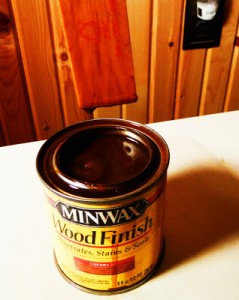Dyes and stains are both used to color wood. To the uninitiated masses both types of products are one in the same. For this reason, these terms are frequently used interchangeably albeit incorrectly. While both dyes and stains are similar in appearance and intended use, the similarity ends there. In fact, dyes and stains each have their own distinct physical properties and resulting performance characteristics.
So how are dyes and stains different? The most salient difference is the colorant used in their formulations. Stains use pigments. These are very large, opaque, insoluble particles. What insoluble means is that you can mix a pigment in a solvent, such as oil or water. While the solvent will temporarily suspend the colorant in the mixture, the pigment will never dissolve. In time, these suspended particles will settle in one globular, muddy mass to the bottom of the can. This is why you need to stir a can of stain before every use to remix the pigment with the solvent. If there is no glob of pigment at the bottom of the can, it’s not really stain.

Is this a stain or dye? After one year on the self, no pigment had settled to the bottom of the can. The thin coating was also very transparent.
Dyes, on the other hand, are comprised of much smaller molecules. The molecules are so small, that light can pass through them unimpeded. While are insoluble, dye particles will dissolve in a particular solvent. If you buy dyes in powdered form, some are formulated to dissolve in alcohol, while others have been developed for water or a solvent such as turpentine, naphtha or lacquer thinner. Once the dye is dissolved in its solvent, it remains as a solution. Never should the particles settle at the bottom of the can.
The composition of stain is similar to that of paint. In fact, some describe stain as being very thin paint. Both paint and stain are comprised of pigment, a solvent and a resin or binder. Applied to wood, while both slightly penetrate the surface, stain and paint are primarily surface coatings.
By comparison, dyes are merely comprised of a colorant and a solvent (either alcohol, water or an oil-based solvent, such as turpentine, lacquer thinner, naptha or toluol). Unlike stain, which coats the surface, the tiny molecules of dye penetrate deeply into the fibers of the wood. Because of this deep penetration, dyes do not require a binder.
The choice of using either a stain or dye is in part subjective. Stains are a popular choice. But the opaque nature of pigments tends to obscure some of the beautiful graining of woods. Being transparent, much more of the wood grain and natural beauty are visible using a dye. With respect to durability, the larger molecules of the pigments used in stains are much more lightfast than dyes. Dyes are typically not very lightfast, including alcohol soluble aniline dyes and oil soluble aniline dyes. Water-based aniline dyes, however, have become popular because they provide improved UV resistance to indoor lighting. Under no circumstances, are any dyes recommended for exterior applications.
Test, Don’t Guess. Whichever you choose, before using either a stain or dye on a project, test the coating on a scrap piece of wood.
If you decide to use or experiment with dyes, you can buy these products in either powdered form or as a premixed liquid. Water-based products will provide better fade resistance than either oil-based or alcohol-based products. To mix the dye using a dry powder, approximately one ounce of powder is combined with a quart of warm water. You can, of course, vary the portions to achieve either a lighter or darker color. Or can create custom colors combining different dyes.
If you use water-based dyes, keep in mind, that these products will raise the grain of wood. The procedure is to first sand the wood, and then moisten the wood to raise the grain. After saturating a rag in distilled water, wring out the excess. Use the damp rag to wipe down the surface. Another method is to spray the surface of the wood with distilled water, using a spray bottle. Either method works. After the grain has raised and thoroughly dried, sand the wood 220-grit sandpaper. To ensure that the wood has dried completely, many woodworkers will wait overnight. You can accelerate drying by gently heating the surface with a heat gun on low to medium heat. After sanding, you can apply a water-based dye. In most cases, the water-based dye will not raise the grain again. Typically, the grain will only rise once.
Before applying the dye to the surface of the wood, spray the surface again with the spray bottle. Moistening the wood just before brushing or wiping on the dye, will prevent any blotchiness and produce a more even and aesthetically pleasing appearance.
Whichever type of dye you use, you will need to work fast to avoid lap marks. Using an alcohol-based dye, you will need to work especially fast, because alcohol dries like right now. Water-based dies are easier to work with, because they have a longer open time.
One useful technique when working with any of these dyes is that once applied to a surface, you can lighten the coloring by wiping the surface of the wood with a rag saturated with the solvent used in the dye.
Wiping technique when applying stains. Because the pigment in stain is opaque and tends to hide the wood grain, you can wipe it on and then before it dries, wipe it off. The colorant lodges itself in the open microscopic irregularities of the wood’s surface. Using the wiping technique, can bring out the dramatic contrast in the grain of the wood. While you will not achieve this contrast when dying wood, dyes produce deeper, more uniform color. This is especially true when working with a very hard wood.

My crucifix carving was dyed with an alcohol-based analine dye. After the dye had thoroughly dried, the carving was treated with several coats of tung oil. Read more about drying oils at Finishing with Tung Oil.
You can apply dyes or stains with either a brush or rag. Foam brushes are especially helpful in applying dyes. To produce a really uniform appearance, you can also spray dyes.
To achieve a richer color, you can also use a dye in conjunction with a stain. For example, you could dye a wooden piece to achieve an undertone. Then after the piece in thoroughly dry, you could wipe on a stain. While the stain is still wet, wipe off the excess. After the stain dries, you can complete the job with your favorite finish, such as varnish or lacquer.


